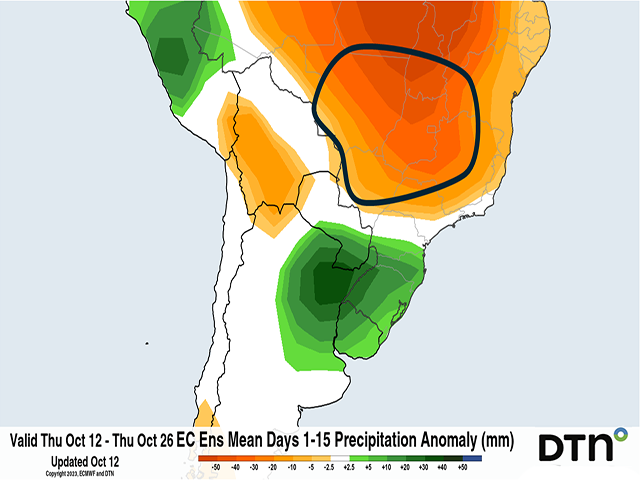Ag Weather Forum
Should We Be Concerned About a Drier Central Brazil?
I am seeing more and more chatter talking about the dry conditions in central Brazil and the potential for reduced crop sizes for soybeans. There is more talk about how this may affect the second-season (safrinha) corn crop, which is expected to be smaller anyway based on estimates from Conab.
The reason behind the overall lower safrinha corn crop this year is tied to poor domestic prices instead of weather. But could the weather situation further that process? Let's discuss.
The wet season in central Brazil (the states of Mato Grosso, Mato Grosso do Sul, Goias, and Minas Gerais) started generally on time in late September. However, the showers that have developed have been awfully spotty and light when compared to normal. During the last two weeks, widespread areas of Mato Grosso and Mato Grosso do Sul have received less than 50% of the normal rainfall amounts. However, there have also been areas in these two states, as well as larger portions of Goias and Minas Gerais, that have estimates above normal. It is not as dire out there now as some have been suggesting.
Planting pace is also off to an average pace. According to the Mato Grosso Institute of Agricultural Economy (IMEA), as of Oct. 6, soybean planting progress in the state of Mato Grosso, the largest producer of corn and soybeans in Brazil, is at 14% complete compared to 12% average and 18% last year. It is still early, but planting progress is being made. Goias is at 6%, and southern neighbor Parana, which has had better rainfall, is at a record-fast pace of 31% complete.
P[L1] D[0x0] M[300x250] OOP[F] ADUNIT[] T[]
There are some dry areas out there, and the wet season rains have been a bit disappointing so far, but they have been around and not completely absent as they were in 2020 until mid-October. Thus, there is not a lot of concern at the start.
But the forecast is not a very favorable one. Fronts continue to move through Argentina and into southern Brazil, lighting up over the southern states, but drying out and interrupting the normal pattern for pop-up wet season showers in central states. This general forecast continues through the end of the month. Rain showers will still be around, but they have much less coverage and overall intensity than we would expect.
Forecasts over the next two weeks point to 40-80% of normal precipitation in the central states. With much of the planting season still in front of us, will producers continue to wait to plant their first-crop soybeans? Or will they continue to plant on-time anyway? That is hard to say. Being below normal for rainfall in October is not a good thing, but is it necessarily a bad thing? Producers in the U.S. know that early-season rains are not all that important for a good soybean crop. Those rains are most important during flowering and especially the pod-fill period, which will occur during the heart of the wet season in December and January.
However, producers in Brazil do not have as good of soil as producers here in the U.S., and the soils there had been completely dry for months during the dry season. Producers may opt for better coverage of significant rain to ensure good germination and early growth.
If they indeed wait, that will push off soybean development and eventually harvest deeper into 2024. The longer that occurs, the less time there is for a good safrinha corn crop. Planting immediately after soybeans are harvested in late January and February, producers hope to get corn through pollination before the wet season rains shut down in early May, then rely on subsoil moisture to fill out the crop. If they push back planting, that will risk more of the crop being exposed to the dry season. With how poor domestic prices are, that could persuade some producers to skip a safrinha crop altogether, or switch to a different, short-season crop. The concerns are valid, but only if we start to see evidence that soybean planting has been delayed. So far, it has not.
To find more international weather conditions and your local forecast from DTN, visit https://www.dtnpf.com/….
John Baranick can be reached at john.baranick@dtn.com
(c) Copyright 2023 DTN, LLC. All rights reserved.





Comments
To comment, please Log In or Join our Community .